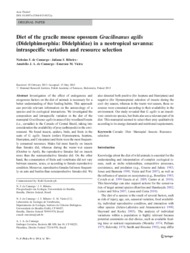Diet of the gracile mouse opossum Gracilinanus agilis (Didelphimorphia: Didelphidae) in a neotropical savanna: intraspecific variation and resource selection.
Diet of the gracile mouse opossum Gracilinanus agilis (Didelphimorphia: Didelphidae) in a neotropical savanna: intraspecific variation and resource selection.
Author(s): CAMARGO, N. F. de; RIBEIRO, J. F.; CAMARGO, A. J. A. de; VIEIRA, E. M.
Summary: Investigation of the effect of endogenous and exogenous factors on the diet of animals is necessary for a better understanding of their feeding habits. This approach can provide relevant information on the autoecology of a species and its ecological interactions. We investigated the composition and intraspecific variation in the diet of the marsupial Gracilinanus agilis in areas of dry woodland forests (i.e., cerradão) in the Cerrado of Central Brazil, taking into consideration the availability of prey (arthropods) in the environment. We found insects, spiders, birds, and fruits in the scats of G. agilis. Insects (orders Hymenoptera, Isoptera, Hemiptera, and Coleoptera) and fruits were the most frequently consumed resources. Males fed more heavily on insects than females did, whereas during the warm?wet season (October to April), the reproductive females fed on insects more than the nonreproductive females did. On the other hand, the consumption of fruits and vertebrates did not vary between seasons, sexes, or according to female reproductive condition. Moreover, reproductive females fed more frequently on ants and beetles than nonreproductive females did. We also detected both positive (for Isoptera and Hemiptera) and negative (for Hymenoptera) selection of insects during the cool?dry season, whereas in the warm?wet season, these resources were consumed according to their availability in the environment. Our study revealed that G. agilis is an insectivore?omnivore species, but fruits also are a relevant part of its diet. This marsupial seemed to select their prey qualitatively according to its energy demands and nutritional requirements.
Publication year: 2013
Types of publication: Journal article
Unit: Embrapa Cerrados
Observation
Some of Embrapa's publications are published as ePub files. To read them, use or download one of the following free software options to your computer or mobile device. Android: Google Play Books; IOS: iBooks; Windows and Linux: Calibre.
Access other publications
Access the Agricultural Research Database (BDPA) to consult Embrapa's full library collection and records.
Visit Embrapa Bookstore to purchase books and other publications sold by Embrapa.

